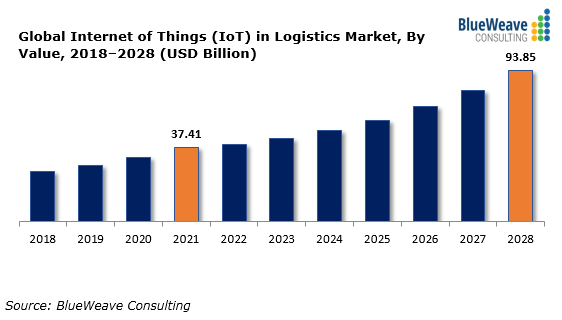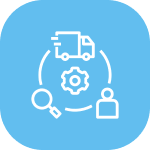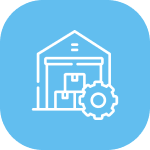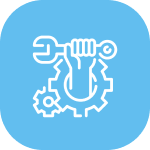The transportation and logistics sector is always filled with a multitude of simultaneously moving parts. Orders get placed, inventory levels require constant monitoring, delivery trucks face delays, products get returned, and so on. With so much going on and each step of operations relying on the previous one, it’s easy for a seemingly small issue to cause a ripple effect and significantly hinder efficiency.
That’s why, in recent years, logistics and transportation companies have been looking at emerging technologies to help optimize their processes. One such innovation that has had a particularly positive impact on the sector is the Internet of Things (IoT). As you may know, the term refers to the implementation of smart devices that facilitate a constant data transfer between physical objects and software that runs speedy analytics.
The popularity of this technology continues to grow so much that the global IoT in logistics market is expected to reach $93.85 billion by 2028, growing at a CAGR of 14%.

However, if you haven’t yet embraced IoT and are just considering it, you might be curious about the benefits it can deliver to your business. In that case, you’ve come to the right place because in today’s post we’ll discuss the advantages and top use cases of IoT in transportation and logistics. Let’s take a look
Benefits of IoT Applications in Transportation and Logistics
Of course, company leaders are primarily interested in the advantages they may observe following the implementation of a particular technology. So, let’s first cover the main benefits of incorporating IoT in the transportation business.
Smooth Supply Chain Planning
As we’ve already mentioned, IoT-powered tools allow companies to acquire information about far-removed physical objects and base decisions on accurate, real-time data. Considering that the supply chain is often managed from afar, this capability can truly come in handy.
By providing timely information on delivery routes, inventory levels, machinery safety, and so on, IoT solutions can simplify supply chain planning activities. Primarily because they help anticipate issues and thus avoid major disruptions.
Reduced Costs
As a consequence of fewer transportation or logistical challenges, costs will naturally decrease following the implementation of IoT tools. Think about it, if you manage to optimize routes in a way that reduces empty miles or minimize product spoilage by controlling conditions under which it is transported — there will be fewer expenses on your books.
Since the Internet of Things can do all of those things in the transportation sector, it is a technology many business leaders are eager to integrate into their IT infrastructure.
Data-Driven Decision-Making
Finally, a major benefit of IoT for logistics organizations is that it empowers them with insights they otherwise wouldn’t have had seamless access to. This, in turn, enables truly data-driven decision-making.
For example, with the help of IoT devices, your delivery staff will immediately know if there is a traffic issue with a route they were planning to take. Moreover, the software might even suggest other route options and the corresponding arrival times. That way, drivers will be able to make a decision on how to pursue by having all the relevant information on-hand.
Top IoT in Transportation and Logistics Use Cases
Now, let’s dive into the specifics and look over the main IoT use cases in the transportation industry. Here, we’ve chosen to focus on the seven that are most impactful, but the truth is we’re only on the precipice of all that this technology is going to do.
Route Optimization

One of the most exciting examples of IoT in transportation is its use for route optimization. By combining real-time traffic data with information on various restrictions and carrying out analytics swiftly, IoT-powered tools can suggest optimal routes that reduce excess miles.
Discover the 6 Types of Data Analysis for Business
An excellent example of this use case comes from the world-renowned UPS. The company has been investing heavily into its dynamic routing technology and has announced that it now saves the company 2-4 miles per driver. Considering UPS’s wide spanning network, these numbers are quite significant and translate positively onto the bottom line.
Inventory Management

Another major use case of IoT sensors in transportation relates to inventory management. Here, intelligent devices are installed within the warehouse or concrete containers to continuously monitor inventory levels. Thus, eliminating the need for manual checks and allowing your software to automatically create new orders whenever stock is running low.
RFID tags are also gaining popularity in this sphere. Their role is in sharing location data of particular packages or pallets through the cloud. That way, whenever a container is unloaded, the RFID updates the inventory automatically. So, your employees don’t have to scan every item themselves.
Additionally, when coupled with artificial intelligence or machine learning algorithms, IoT devices can also study inventory-related patterns and forecast overstocks and understocks. If your company works closely with retailers, this can be particularly interesting for them.
Take a look at how we built a Warehouse Management App for Inventory Tracking
Predictive Maintenance

Another use case worth mentioning in this roundup is predictive maintenance. This IoT capability is most often leveraged by manufacturing companies, but can actually be useful for transport organizations too.
Here, by installing smart devices into warehouse machinery or even car tires, faults and defects can be identified before any major disruption occurs. This is accomplished thanks to the constant real-time data collection, which the system can then analyze to identify patterns that foreshadow issues.
Once the algorithm suspects a malfunction is just around the corner, it will suggest maintenance action that can prevent the equipment from being out of service for too long. As you can imagine, this can result in substantial cost savings.
Condition Control

Often, logistics companies are in charge of transporting products that are highly temperature or humidity sensitive. As such, monitoring the conditions under which they are delivered is of utmost importance.
Unsurprisingly, this is where the integration of IoT devices into transportation vehicles can help. Similar to the other use cases, IoT devices continuously transfer relevant information while products are in transit.
Then, whenever subpar conditions are detected, the system can automatically adjust the temperature and other elements or alert the relevant personnel so that they can take care of it.
Read on to discover how we developed a Cold Chain Monitoring System
Theft Detection

Security is important in any line of work, and logistics is no exception. Ensuring warehouse and shipment safety is a top priority for organizations, and that’s why many are turning to connected devices for help.
IoT technologies can help prevent theft, fraud, damage, and other types of losses by detecting trespassers through connected CCTV cameras, alerting management about unauthorized container opening, and the like. Moreover, these applications can quickly block facility doors whenever a threat is suspected.
End-to-End Product Tracing

One of the key tasks of a transportation firm is ensuring that the products are on the right trucks and heading to the correct warehouse or end destination. Thus, keeping track of the goods and everything that’s going on can be very time-consuming and sensitive to even a minor error.
In this regard, RFID tags or AIDC sensors come into play once again as they wirelessly transfer information on a product’s location and where it’s meant to be heading. Naturally, this helps ensure that the entire supply chain process is under control and increase client trust in the organization.
Employee Safety

Working at a warehouse can sometimes pose a little danger, with all the heavy manual work and constantly moving equipment around. As such, business leaders are often increasingly concerned about ensuring their employees stay safe.
Here, IoT can once again come to the rescue in the form of wearable devices that assess staff fatigue, heart rate, and can even detect a fall. Once an issue is detected, the system quickly alerts the on-call manager so that he or she can ensure the employee takes a break or even call an ambulance.
Start Your IoT Implementation Journey
As you can see, the Internet of Things has ample benefits to deliver for the transportation and logistics sector. From route optimization and inventory management to employee safety — there are many use cases of this technology that your company can leverage for better operations.
However, we understand it can be difficult to know where to get started. Our team has spent years delivering various IoT-powered solutions to organizations across industries, and we’d be happy to contribute our expertise to your next project.
So, if you’re looking to get started with IoT, don’t hesitate to reach out to Velvetech. We have worked on numerous successful logistics and transportation software projects and would be thrilled to dive into a new one.









